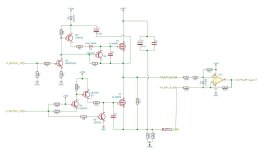flute2k3@hotmail.com
10 W
- Joined
- Nov 26, 2019
- Messages
- 96
for FOC control, I know ST developed a well good tool for 1,2,3-shunt current censoring, however there is a trend applying mosfet Rds on resistance current sensing technology, the well know case is the hoverboard at here:
https://github.com/lucysrausch/hoverboard-firmware-hack
see the mosfet Rds on resistance current sensing detail:

also votol series EM-30s/50/100 using the same way, there is no mosfet current sensing resistor at all but one bus current resistor.
searching through the google/github I can't find any material explains this technical in detail, the hoverboard-firmware-hack does not really use the opamp for current sensing at all after I checked the source codes, it applies a very rough open loop/simplified current control method. obviously it has huge benefit if we can develop a generic firmware suitable for this topology. it is simple, less power consumption and very popular nowadays, can replace the original firmware keep using the decent hardware, box and terminals, while add more function eg. Bluetooth, CAN bus or even make it compatible with VESC tool.
anyone would like to share some more understanding on this detail?
https://github.com/lucysrausch/hoverboard-firmware-hack
see the mosfet Rds on resistance current sensing detail:

also votol series EM-30s/50/100 using the same way, there is no mosfet current sensing resistor at all but one bus current resistor.
searching through the google/github I can't find any material explains this technical in detail, the hoverboard-firmware-hack does not really use the opamp for current sensing at all after I checked the source codes, it applies a very rough open loop/simplified current control method. obviously it has huge benefit if we can develop a generic firmware suitable for this topology. it is simple, less power consumption and very popular nowadays, can replace the original firmware keep using the decent hardware, box and terminals, while add more function eg. Bluetooth, CAN bus or even make it compatible with VESC tool.
anyone would like to share some more understanding on this detail?


